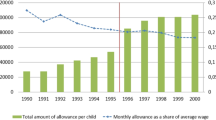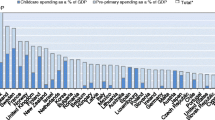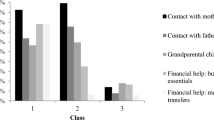Abstract
Using data on 2,317 mother–daughter pairs from 10 European countries, we investigate the impact of downward time and monetary transfers on the career choices of transfer-receiving young mothers. For Europe as a whole, we find a strong positive effect of grandchild care on the labor force participation and the degree of labor market involvement of the young mother, but no impact of monetary transfers on either of these decisions. Both recipients and donors with better endowments are more likely to participate in a monetary transaction, while mothers with lower level of human capital are more likely to provide time transfers to their better endowed daughters.



Similar content being viewed by others
Notes
See for instance the special issue of the Journal of Labor Economics (1985).
We assume income pooling at the household level for both the parent and the child, meaning that we neglect complex bargaining issues between spouses for each generation.
The inability of providers of monetary as opposed to in-kind transfers to have full control over the choices made by the recipient makes the theoretical modelling of this possibility difficult (Pollak 1988). Furthermore, for the purposes of our empirical analysis, we have no information on the specific use a monetary transfer. We do however control for differences in the availability of formal care by including country variables in our regressions and hence explore the impact of both time and monetary transfers, conditional on exogenously given institutionalized childcare resources.
Interestingly, this standard first-order condition which links the parent’s and child’s marginal utility of consumption also holds in the basic altruistic model (Laferrère and Wolff 2006).
For further information and download of the data, see the following url http://www.share-project.org. The countries included in the first release of SHARE (2004) are Austria, Germany, Netherlands, Sweden, Spain, Italy, Denmark, France, Greece, and Switzerland.
While our data set does not provide a health variable for the daughter, we include a health variable of the mother in the transfer equations. The rationale for this is that health may be a larger determinant of economic outcomes for the mother, given her age, and may therefore be an important proxy for opportunity costs in her decision to provide transfers.
The mean of further education exceeds 0.75–0.80 in the case of monetary receipt whether simultaneously with a time transfer or without a time transfer, the mean of further education ranges around 0.60 among mothers not receiving monetary transfers. In addition, we find higher means of the current income variables among providers of monetary, as opposed to providers of time transfers.
A shortcoming of the data is that we have no information on the daughter’s location. For instance, there may be some differences in the supply of childcare services depending on whether the daughter lives in a rural or urban area.
We also exclude the monetary transfer variable from the regression, as there is no sufficient variability of that covariate at the family level to get robust findings.
The same pattern is expected if the daughter and her mother are in the same household. A decrease in the household income due to a bad shock will induce the daughter to work outside and will encourage the mother to take care of grandchildren according to the division of labor within the family.
References
Arrondel L, Masson A (2006) Altruism, exchange or indirect reciprocity: what do the data on family transfers show? In: Kolm SC, Mercier Ythier J (eds) Handbook on the economics of diving, reciprocity and altruism. North-Holland, Elsevier
Becker G, Tomes N (1976) Child endowments and the quantity and quality of children. J Polit Econ 84(4):S143–S162
Beetsma B, Broer P (2003) The budgeting and economic consequences of ageing in the Netherlands. Econ Model 20(5):987–1013
Blau D, Robins P (1988) Child-care costs and family labor supply. Rev Econ Stat 70(3):374–381
Boaz RF, Muller CF (1992) Paid work and unpaid help by caregivers of the disabled and frail elders. Med Care 30(2):149–158
Börsch-Supan A (2001) Labor market consequences of population ageing. NBER Working Paper 8640
Cappellari L, Jenkins SP (2003) Multivariate probit regression using simulated maximum likelihood. Stata J 3(3):278–294
Cardia E, Ng S (2003) Intergenerational transmission of time and childcare. Rev Econ Dyn 6(2):431–454
Cox D (1987) Motives for private income transfers. J Polit Econ 95(3):508–546
Dench G, Ogg J (2001) Grands-Parents par la Fille, Grands-Parents par le Fils. In: Attias-Donfut C, Segalen M (eds) Le Siècle des Grands-Parents. Une Génération Phare, Ici et Ailleurs. Editions Autrement, Paris
Dench G, Ogg J (2002) Grandparenting in Britain. Institute of Community Studies, Great Britain
Dimova R, Wolff FC (2008) Grandchild care transfers by ageing immigrants in France: intra-household allocation and labor market implications. Eur J Popul 24(3):315–340
Dustmann C, Micklewright J, van Soest A (2009) In-school labor supply, parental transfers, and wages. Empir Econ 37(1):201–218
Ehrenberg R, Sherman D (1987) Employment while in college, academic achievement, and postgraduate outcomes: a summary of results. J Hum Resour 32(1):1–23
Ettner SL (1995) The impact of parent care on female labor supply decisions. Demography 32(1):63–79
Ettner SL (1996) The opportunity costs of elder care. J Hum Resour 31(1):189–205
Gauthier A (2002) Family policies in industrialized countries: is there a convergence? Population 57(3):447–474
Gerhard U, Knijn T, Weckwert A (2005) Working mothers in Europe. A comparison of policies and practices. Edward Elgar, Cheltenham
Greene WH (2004) The behavior of the fixed effect estimator in nonlinear models. Econom J 7(1):98–119
Gronau R (1973) The effect of children on housewife’s value of time. J Polit Econ 81(2):S168–S199
Heckman J (1974) Effects of child-care programs on women’s work effort. J Polit Econ 82(2):S136–S163
Herlyn I (2001) D’Est en Ouest, les Styles des Grands-Mères Allemandes. In: Attias-Donfut C, Segalen M (eds) Le Siècle des Grands-Parents. Une génération Phare, Ici et Ailleurs. Editions Autrement, Paris
Journal of Labor Economics (1985) Special issue on trends in women’s work, education and family building 31(1)
Laferrère A, Wolff FC (2006) Microeconomic models of family transfers. In: Kolm SC, Mercier Ythier J (eds) Handbook on the economics of giving, reciprocity and altruism. North-Holland, Elsevier
Leira A (1991) Welfare states and working mothers. The Scandinavian experience. Cambridge University Press, Cambridge
Leira A, Tobio C, Trifiletti R (2005) Kinship and informal support: care resources for the first generation of working mothers in Norway, Italy and Spain. In: Gerhard U, Knijn T, Weckwert A (eds) Working mothers in Europe: a comparison of policies and practices. Edward Elgar, Cheltenham
Ogawa N, Ermisch JF (1996) Family structure, home time demands and the employment patterns of Japanese married women. J Labor Econ 14(4):677–702
Pezzin LE, Schone B (1999) Intergenerational household formation, female labor supply, and informal caregiving: a bargaining approach. J Hum Resour 34(3):475–503
Pollak RA (1988) Tied transfers and paternalistic preferences. Am Econ Rev 78(2):245–250.
Sasaki M (2002) The causal effect of family structure on labor force participation among Japanese married women. J Hum Resour 37(2):429–440
Tobio C (2001) En Espagne, la Abuela au Secours des Mères Actives. In: Attias-Donfut C, Segalen M (eds) Le Siècle des Grands-Parents. Une Génération Phare, Ici et Ailleurs. Editions Autrement, Paris
Wolff FC (2006) Parental transfers and the labor supply of children. J Popul Econ 19(4):853–877
Author information
Authors and Affiliations
Corresponding author
Additional information
Responsible editor: James Albrecht
We thank two anonymous referees and the editor, James Albrecht, for their insightful comments and suggestions. We also thank Claudine Attias-Donfut, Sumon Bhaumik, Philip Cohen, Lionel Prouteau, André Masson, Judith Tress, and seminar participants at Brunel University, INSEE, Nantes University, the Annual Conference of the Population Association America at Los Angeles, the 23èmes Journées de Microéconomie Appliquée in Nantes, the Annual Conference of the European Society for Population Economics in Verona and the European Association of Labor Economists in Prague. Financial support from the RTN project on Grandparenting and Intergenerational Relations in Ageing European Societies is gratefully acknowledged. All remaining disclaimers apply.
Rights and permissions
About this article
Cite this article
Dimova, R., Wolff, FC. Do downward private transfers enhance maternal labor supply? Evidence from around Europe. J Popul Econ 24, 911–933 (2011). https://doi.org/10.1007/s00148-010-0305-0
Received:
Accepted:
Published:
Issue Date:
DOI: https://doi.org/10.1007/s00148-010-0305-0




